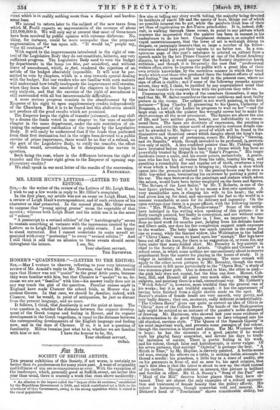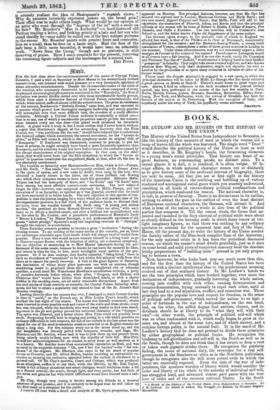lira It.
SOCIETY OF BRITISH ARTISTS.
THE present exhibition of this Society, if not worse, is certainly no better than its predecessors formany years past. A want of originality and loftiness of aim are as conspicuous as ever. With the exception of the landscapes, which, generally good at Suffolk-street, are better this year than usual, there is scarcely a work that rises above mediocrity; * An allusion to the impost called the " impost of the 45 centimes," established by the Republican Government in 1848, and which contributed not a little to the overthrow of that Government, owing to the strong opposition which it raised in the rural population. few aim at telling any story worth telling, the majority being devoted to incidents of rustic life and the sports of boys, things out of which no possible interest can be got while the painters think less of their art than of captivating an Art-tnion prizeholder. It is, indeed, diffi- cult, in walking through these rooms, to point to any picture which conveys the impression that the painter has been in earnest in his endeavours to do his best. Complacent dulness is so mingled with vapid meretriciousness, that the lover of art is well-nigh driven to despair, or yawningly laments.that so large a number of his fellow- creatures should have put their talents to no better use. In a con- spicuous page of this year's catalogue is printed an extract from a speech made by the late Prince Consort at one of the Royal Academy dinners, by winch it would appear that the Society deprecates harsh criticism • and though it is frequently the case that " professional writers often strive to impress the public with a great idea of their own artistic knowledge, by the merciless manner in which they treat works which cost those who produced them the highest efforts of mind and feeling," the remark will not hold in the present case, where no sign, of effort is visible ; and if some of the following remarks appear severe, they will, I think, be justified by any unprejudiced mind that takes the trouble to compare them. with the pictures they refer to.
Commencing with the works of the members themselves, it may be said that. Mr. W. Salter contributes the most ambitions and. most faulty picture m the rooms. The subject is not worth painting, in the first instance—" King Charles II. presenting to his Q,ueen, Catherine of Bra„eanza, a List of the Ladies he proposes to wait on her"---and the large scale on which the painter has wrought serves but to make his short-comings all the more prominent. The figures are above the size of life, and have neither grace, beauty, nor individuality to recom- mend them. The faces are destitute of expression, the painting is common, and even the minor merit of accuracy in costume details can- not be awarded to Mr. Salter—a proof of which will be found in the diminutive and theatrical sword which dangles about the king's legs. Next to ,this in point of pretension, comes Mr. Pidding's " Gaining, and its Results," which, though intended to be profound, is, provoca- tive only of mirth. I less confident painter than Mr. Pidding might have hesitated before trying his hand,, on a theme which has been so powerfully treated by Hog,arth in his "Rake's Progress." His tragic incidents cause a smile, and his comic points, melancholy. A gentle- man who has lost his all rushes from the table, tearing his wig, and gnashing a remarkably fine and regular set of teeth, overturns a tray of wine which a black servant is bringing in; through a door which opens into the grounds attached to the gaming-house may be seen a little lop-sided man, terminating his existence by putting a pistol to his ear. The care bestowed on the paintings and statues whit& adorn the saloon, would have been better employed on the faces and figures. "The Return of the Lost Sailor," by Mr. T. Roberts, is one of the best figure pictures, but it is by no means a first-rate specimen. .A very unsailorlike man is clasping his wife to his heart; the wife had given him up for dead, and announced the fact to the world in a manner remarkable at once for its delicacy and ingenuity. On the open cottage-door there is a paper affixed, with the following inscrip- tion: "Mrs. Wilson, Widow, Needlewoman!" Some of the critics have indulged in fine writing when speaking of this picture : it is fairly enough painted, but faulty in conception, and not without some questionable drawing. The sailor is, I fear, an impostor; he has done no hard work for months past, judging from his delicate hands and ffibert nails, nor does his fair complexion suggest much exposure to the weather. The baby takes too much interest in the scene for one so young, while the fancied widow, like Widrington in the ballad of "Chevy Chase," seems to kneel upon her "stumps." Her legs have been cat, off at the knee, for there is no suggestion of, or room for, any form under that many-folded skirt. Mr. Bromley is boy-painter. in chief to the Society of British Artists. "Oughts and Crosses" is a school scene, in which some urchins are unconsciously about to receive punishment from the master for playing in the hours of study. It is vulgar in incident, and coarse in painting. The same remark will apply to the other seven pictures by Mr. Bromley, though the want of refinement is felt more particularly in the "Opera Box," a study of two common-place girls. One is dressed in blue, the other in pink— the pink lady does not squint, but the blue one does. Messrs. Cob- bett, Hill, and Henzell all paint very much alike, selecting similar subjects, mid painting them in a dull, unemotional way. Mr. Cobbett's "Welsh School!' is, however, more truthful than the general run of his works; but it is not truthful enough: it has the appearance of having been finished from a slight sketch made on the spot. Mr. Baxter's studies of female heads are very smooth, very pretty, and very badly drawn; they are, moreover, sadly deficient in individuality. "The Colleen BEVfn" gives one quite as correct an idea of Olivia as "Olivia" does of the Colleen Bawn. The hands of the Shakspearian lady might be noticed as an instance of the painter's noble disregard of drawing. Mr. Hurlstone, who showed last year some evidence of a determination to do good things, seems to have relapsed into his old slipshod, careless style. "The Queen of the Spanish Gipsies" is his most important work, and presents some passages of fair colour, though the execution is blurred and slimy. For Mr. Woolmer there is hope; he has the elements of a good painter if he would curb his playful fancy somewhat, and devote his days to truth- ful imitation of nature. There is poetic feeling in his work, and his colour, though false and kaleidoscopic, is never vulgar. Of his seven pictures, that entitled " Ophelia" is perhaps the best. "A Stitch in 'rime," by Mr. Rayner, is cleverly painted. A bottle-nosed old man, resting his elbows on a table, is making feeble attempts ,t0 thread a needle: his grandson, a little boy in a state of nudity, sits on his garments in front of, and so near to, his aged relative, that one's first idea is that the latter is about to sew up the child instead of its clothes. Though deficient in interest, this picture is brilliant and forcible in effect. Mr. G. A. Storey's "Song of the Past" and "Maid of the Mill" deserve better places than, they have oh- tamed. They are almost the only examples of a refined apprecia- tion and treatment of female beauty that the gallery affords. His colour is harmonious, though somewhat cold and neutral. Mr. Dicksee's head of "Touchstone" shows considerable ability, but it scarcely realizes the idea of Shakspeare's " roguish clown." Why do pauiters invariably repre,seut What on the broad grin? Their office was to make others laugh_ would be our opinion of an actor who went through the "degrees of the lie" with a smile on his face? Mr. Rossiter's "Man in Authority"—a hard-featured old Puritan reading a letter, and looking grimly at a lady and her son who stand timidly by—may safely be called one of the best cabinet pictures in the rooms. Mr. Rossiter paints with greater force and concentra- tion on a small, than he does on a large scale. Had the face of the lady been a little more beautiful, it would have been an admirable work. "News from the Camp," though not so pictorial, is still deserving of praise. Here I must conclude for the present, reserving the remaining figure subjects and the landscapes for a second visit.
DRY POINT.































 Previous page
Previous page